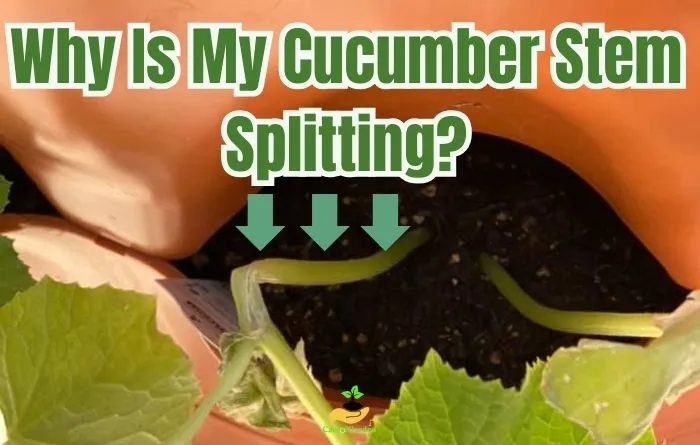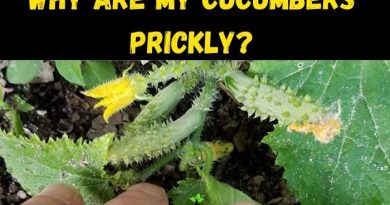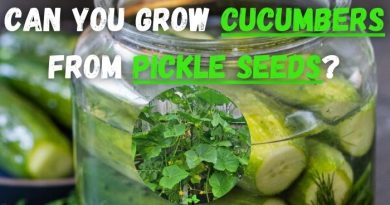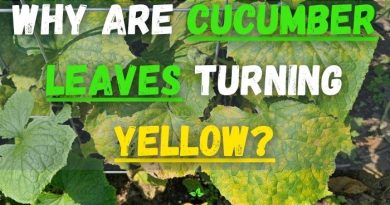Why are My Cucumber Stems Splitting? Find Out Now!
Ever wondered why your cucumber stems are splitting apart? I did too, and I’ve got the answers you need! In this article, I will explore the causes of cucumber stem splitting in your garden and provide valuable insights on how to prevent it.
My cucumber stem is splitting due to several causes, including cold damage, windy conditions, and rapid growth. Cold temperatures below 60°F make cucumber stems vulnerable to splitting, often near the soil line, which can lead to infections. Strong winds can snap or twist cucumber plants at the soil line, resulting in stem splitting. Rapid growth due to high temperatures, excessive irrigation, or fertilization can exert pressure on cucumber stems, making them prone to splitting.
Key Takeaways:
- Cold damage, particularly temperatures below 60°F, is a common cause of cucumber stem splitting.
- Windy conditions can cause cucumber plants to snap off or twist, leading to stem splitting.
- Rapid growth due to high temperatures, increased irrigation, or fertilization can contribute to stem splitting.
- After a cold snap, carefully assess the extent of damage and consider replacing severely affected plants.
- Applying protectant fungicides/bactericides can help reduce the risk of infections on damaged cucumber stems.
Common Causes of Cucumber Stem Splitting
| Causes of Cucumber Stem Splitting | Effects |
|---|---|
| 1. Cold Temperatures | Stem splitting at or near the soil line |
| 2. Strong Winds | Plants snapping off or twisting at the soil line |
| 3. Rapid Growth | Increased pressure on the stems, making them prone to splitting |
1. Cold Temperatures
In my experience as a gardener, I’ve found that cold temperatures can cause cucumber stems to split. When the temperature drops below 60°F, the water inside the stem can freeze and expand, putting pressure on the stem walls.
This pressure can cause the stem to split, especially near the soil line, and often manifests on one side of the stem.
This is because lower temperatures can reduce the flexibility of the stem, making it more prone to cracking.
The splitting of the stems not only compromises the structural integrity of the plant but also creates entry points for infections to take hold.
Solution
Please remember that early intervention and attentive care are key to overcoming cold damage and promoting the healthy growth of your cucumber plants.
After a cold snap, one crucial piece of advice I can give you is to assess the extent of the damage to your cucumber plant stem for any visible splitting or cracking.
Table 1: Assessment of Cold Damage
| Severity of Damage | Recommended Action |
|---|---|
| Minor splitting or superficial cracks | Monitor closely; plants may recover |
| Deep and extensive splits | Consider replacing affected plants |
| No splitting or cracks | No immediate action required |
https://careofgarden.com/how-cold-can-cucumber-plants-tolerate/
If you notice any deep and severe stem splits that extend into your cucumber plant tissue, I suggest you replace the affected cucumbers. Keep in mind that minor splitting or superficial cracks can heal on their own as the plants continue to grow and recover.
To prevent further damage and promote the recovery of your cucumber plants, I make sure they receive sufficient water, sunlight, and nutrients.
Additionally, applying protectant fungicides and bactericides can help reduce the risk of infections on damaged tissues, further supporting the plants’ healing process.
2. Strong Winds
Wind can physically stress the cucumber plant, especially if it’s growing on a trellis or support structure. The constant movement of the plant can weaken the stems and lead to splitting or snapping off at the soil line.
Based on my gardening experience, this kind of stem damage can leave your cucumber plants vulnerable to infections, which can significantly hinder their growth and stop productivity.
Solution
During periods when I’ve encountered strong winds in my garden, I’ve found it crucial to take some proactive steps to safeguard my cucumber plants. To stabilize the stems and reduce the risk of splitting, I’ve provided support through methods like staking or trellising.
I’ve also taken measures to create windbreaks, such as using fencing or planting taller crops nearby. These techniques have proven effective in shielding my cucumber plants from the force of strong winds and minimizing potential damage.
Additionally, using lightweight row covers or fabric tunnels can create a protective barrier around your cucumbers, shielding them from the direct impact of the wind.
By implementing these strategies, you can minimize the risk of stem splitting and ensure the overall health and productivity of your cucumber plants.
3. Rapid Growth
The last cause of stem splitting in my cucumbers, I know, is given by rapid growth.
Cucumber plants are known to be vigorous growers, and when they experience sudden bursts of growth, especially in hot and humid conditions, the outer layers of the stem might not keep up with the inner growth.
This can lead to splitting, especially near the base of the stem. When the stems split, it typically occurs at the soil line and is often confined to one side of the stem.
This can be attributed to the uneven distribution of growth and pressure on the stem, causing it to crack and separate.
Solution
To do this, I monitor and adjust my watering schedule to maintain consistent soil moisture, which helps prevent excessive growth spurts.
To mitigate high temperatures and reduce stress on the plants, I provide shade or use reflective mulches. This has been effective in preventing stem splitting.
Ensuring a balanced nutrient supply through proper fertilization is also crucial to promote healthy growth without overstimulating the plants.
I’ve found that by following these strategies, I can manage the contributing factors and prevent stem splitting during periods of rapid growth in my cucumber garden.
How to Recover a Cucumber with a Broken Stem
Here are the detailed steps I take to help my cucumber stem recover:
- Assess the Damage: The first thing I do is carefully examine the extent of the stem break. Is it a partial or complete break? This assessment helps determine the appropriate course of action.
- Prepare Pruning Tools: I gather my pruning shears or a sharp, clean knife. It’s important to use clean tools to prevent infection or further damage to the plant.
- Trim the Broken Stem: If the break is partial and the stem is still hanging on, I gently trim the damaged portion. I make a clean, diagonal cut just above the break, ensuring there are no jagged edges.
- Support the Plant: To provide immediate support to the weakened cucumber plant, I use garden twine or soft plant ties. I loosely tie the stem to a nearby trellis, stake, or any suitable support structure. This prevents further bending or breaking.
- Apply Rooting Hormone (Optional): For added assurance of recovery, I sometimes dip the cut end of the stem in rooting hormone. This can stimulate root growth from the cut area, helping the plant reestablish itself.
- Water Carefully: It’s essential not to overwater the injured cucumber plant, as excess moisture can lead to root rot. I water it just enough to keep the soil consistently moist but not soggy.
- Monitor for Infection: I keep a close eye on the cut area for any signs of infection or disease. If I notice discoloration or rot, I trim it away with sterile tools to prevent it from spreading.
- Maintain Proper Conditions: I ensure the plant receives the right amount of sunlight, nutrients, and care as recommended for cucumber cultivation in my region.
- Patience and Observation: Recovery takes time. I patiently wait and regularly inspect the plant’s progress. New growth should emerge from the cut area within a few days to weeks.
- Remove Support: Once the cucumber plant has fully recovered and shows healthy growth, I carefully remove the supporting ties. By this point, the plant should be strong enough to stand on its own.
Recovering a cucumber plant with a broken stem requires patience and attentive care. Following these steps has helped me nurse my cucumber plants back to health, ensuring a bountiful harvest.
How to Prevent Cucumber Stem Splitting
To prevent cucumber stem splitting, it’s important to follow certain practices that create optimal growing conditions for your plants. Here are some best practices for preventing cucumber stem splitting:
- Provide proper support: Cucumber plants tend to have weak stems, which makes them more susceptible to splitting. Using stakes or trellises can provide support and prevent the stems from bending or breaking under the weight of the fruit. Be sure to secure the plants gently to avoid damaging the stems.
- Maintain consistent moisture: Uneven watering can cause rapid growth, making the cucumber stems more likely to split. Monitor the soil moisture levels and aim for consistent watering. Avoid overwatering, as excessive moisture can lead to fungal infections that further weaken the stems.
- Create a wind barrier: Windy conditions can cause the cucumber plants to snap off or twist at the soil line, resulting in stem splitting. Erecting a wind barrier, such as a fence or planting windbreak plants, can help protect your cucumber plants from the damaging effects of strong winds.
- Avoid excessive nitrogen fertilization: While nitrogen is essential for plant growth, too much nitrogen can lead to rapid growth and weak stems. This, in turn, increases the risk of stem splitting. Make sure to follow the recommended fertilization guidelines for cucumbers and avoid over-fertilizing with nitrogen-rich fertilizers.
- Apply protectant fungicides and bactericides: Stem splitting in cucumbers can create an entry point for pathogens, leading to infections that can significantly impact plant health and productivity. Protectant fungicides are designed to form a barrier on the surface of plant tissues, preventing the establishment and spread of fungal pathogens. They act as a shield, inhibiting the growth and development of harmful organisms that can enter through the split stems. Bactericides, on the other hand, directly target bacteria that may cause infections on damaged tissues. Together, these products provide a comprehensive defense system against potential threats to your cucumber plants.
| Product | Active Ingredient | Application Frequency |
|---|---|---|
| CucumberShield | Copper hydroxide | Every 7-10 days |
| FungAway | Thiophanate-methyl | Every 7 days |
| PlantGuard | Streptomycin sulfate | Every 10-14 days |
Conclusion
Understanding the causes of cucumber stem splitting is essential for preventing this common problem in your garden. By taking proactive measures and implementing the techniques discussed in this article your cucumber stems will remain intact. Happy gardening!
Frequently Asked Questions
Cucumber stems can split due to various factors, including cold temperatures, rapid growth, and windy conditions. Understanding these causes is crucial for effective prevention and maintaining the health of your plants.
To prevent cucumber stem splitting, you can provide support to the stems, avoid excessive irrigation or fertilization, and create wind barriers to protect the plants from strong winds.
Effective solutions for cucumber stem splitting include providing support to damaged stems with stakes or trellises, applying protectant fungicides/bactericides to reduce the risk of infections on damaged tissues, and adjusting irrigation and fertilization practices.
To assess cold damage, carefully evaluate the extent of the damage to the cucumber plant. If the stem splitting is severe and the plant shows no signs of recovery, it may be necessary to replace the affected plant.
Applying protectant fungicides and bactericides can help reduce the risk of infections on damaged cucumber stems. This can prevent further damage and promote the overall health of the plants.




